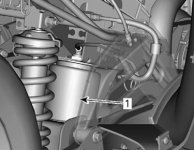robmorg
New member
I converted from 2 to 3 wheels last fall when I purchased my local dealer owner's personal demo 2013 RT Limited. (No loss to him - he's now riding a 2014 model with the larger engine.  ) I've now got almost 1000 miles on my new Spyder and am now leaning properly into turns and no longer over-steering, etc. I'm loving it!
) I've now got almost 1000 miles on my new Spyder and am now leaning properly into turns and no longer over-steering, etc. I'm loving it!
But, I am confused about how the ACS suspension actually works. I've read the manual but it does not seem clear. I understand that the ACS system automatically adjusts the suspension height for the load, and that you can use the buttons to change the automatic settings. I also understand that pushing the top (forward) button stiffens the ride and the bar on the screen goes up. Conversely, pushing the lower (rearward) button softens the ride and makes the indicator bar goes down.
What I do not understand is what is actually happening when the buttons gets pushed. It would seem intuitive that pushing the top button would add more air to make the ride stiffer and pushing the bottom button let's some air out to make it softer. Is that right, or do I have it backwards?
If I'm correct, then why does the manual (page 59) say that the top position on the screen (stiffest setting) is the "Lowest" riding position and bottom position on the screen (softest setting) is the "Highest" riding position? That is counter-intuitive. Wouldn't adding more air make the suspension stiffer by raising it, not lowering it?
Could someone please tell me what I'm missing here. :banghead:
Thanks,
Rob
But, I am confused about how the ACS suspension actually works. I've read the manual but it does not seem clear. I understand that the ACS system automatically adjusts the suspension height for the load, and that you can use the buttons to change the automatic settings. I also understand that pushing the top (forward) button stiffens the ride and the bar on the screen goes up. Conversely, pushing the lower (rearward) button softens the ride and makes the indicator bar goes down.
What I do not understand is what is actually happening when the buttons gets pushed. It would seem intuitive that pushing the top button would add more air to make the ride stiffer and pushing the bottom button let's some air out to make it softer. Is that right, or do I have it backwards?
If I'm correct, then why does the manual (page 59) say that the top position on the screen (stiffest setting) is the "Lowest" riding position and bottom position on the screen (softest setting) is the "Highest" riding position? That is counter-intuitive. Wouldn't adding more air make the suspension stiffer by raising it, not lowering it?
Could someone please tell me what I'm missing here. :banghead:
Thanks,
Rob

